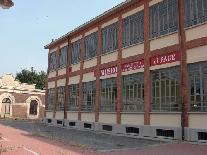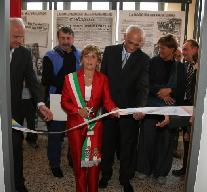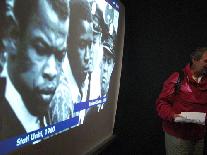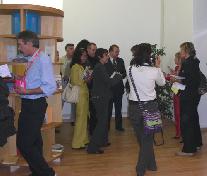EUROPE
The Collegno Peacelab Museum (Italy)
(May 3, 2010)
by Lucetta Sanguinetti, Project Promoter, and Marialessandra Sabarino, Museum Staff
The Collegno Peacelab Museum is the first experiment in museums-for-peace building in Italy. It is the initial step of a much larger project of an International Museum of Nonviolent Resistance against Wars, Dictatorships, Mafias and Human Right Violations. Therefore it is housed in the same building of The Historic Resistance Museum, directly adjoining it.
The Collegno Peacelab Museum was opened by Mayor Accossato in 2008, on the occasion of the International Peace Day of September 21, but the museum itself was realized after a long process of citizens' awareness and participation in issues of peace and nonviolence, with many national/international initiatives by the city, organizations, schools, and the population at large.
A delegation of four representatives from the city of Sarajevo attended the opening ceremony, which was part of the official program of events to mark the 10th anniversary of peace linking the two cities, born when Collegno worked for a nonviolent solidarity during the Balkan War.
BASIC AIMS
In the City for Peace, the Peacelab Museum is an instrument meant to:
1. create a significant and recognizable site in which it could be possible to gather and show the historical experiences of nonviolence, as a symbolic reference for local, national, and international peace initiatives;
2. provide a special peace-meeting area, a participation space, a laboratory to prepare new actions informed by the values of nonviolence, trained by means of peaceful creative tools;
3. stimulate ideas and thoughts in museum visitors through an emotional experience of the museum that can turn their participation into a choice to become a protagonist of change;
4. discuss in depth, promote, and elaborate the city's peace policies, in light of its membership in the International Network of Museums for Peace.
Currently, the Peacelab Museum greets visitors with an interactive path to experience nonviolent work. The images, shown on the whole width of the wall, are the main objects of the museum. Different guided tours, films, and seminars invite visitors to reflect, discuss, and get involved.
THE PATH
The path first leads visitors into a dark, narrow space where a movie plays, showing scenes of violence and war. The noises grow loud, and the music more distressing, plunging visitors into an experience of anxiety, injustice, and powerlessness. The path then proceeds to a colorful and calm space where visitors can share their thoughts and feelings regarding the strong emotions they have experienced. The third stage along the path is an interactive video featuring various instances of nonviolent resistance in the world: a large planisphere can be clicked to learn more about each of these examples of nonviolent resistance. The fourth aspect of the path focuses on five symbolic and theoretical points for reflection, corresponding to the five Galtung approaches in the constructive handling of conflict (speech at the United Nations in New York on October 2, 2007 for the International Day of Nonviolence).
Point 1: Never fear dialogue
In his many struggles, Gandhi engaged in dialogue with everyone, including adversaries of the British Empire he had come to loathe. And this dialogue bore fruit.
Point 2: Never fear conflict, it presents more opportunity than danger
For Gandhi, conflict was seen as a challenge in which adversaries could come to know each other, analyze the roots of the problem in depth, arrive at a creative transformation of differences.
Point 3: Know History or you are doomed to repeat it
The memory of most perpetrators is short while their victims never forget. Acknowledgment of the trauma inflicted and reconciliation between the parties are vital.
Point 4: Imagine the future or it will never appear
"Be the future today that you want to see tomorrow"
Point 5: While fighting occupation, clean up your own house!
While Gandhi was resisting the British Empire and fighting for self-governance, he was also attending to such ills of his own country as the issue of the untouchables, the discrimination of women, poverty, and the growing divide between Hindus and Muslims. What could we learn from Gandhi in addition to turning from violence to nonviolence in today's conflicts?
Each one of these points can be explored in depth and practiced by visitors through experiential activities. The choice of tools is flexible, depending on the target.
A large library and a wall map of peace sites are at the last stage of the path of nonviolence. Before leaving the Peacelab Museum, the visitors are given a brochure with the tour map and the highlights to remember the experience. They are also asked to write down their feedback and hand it to the staff as a means of continually improving the museum arrangement and organization.
The Peacelab Museum offers educational activities for high schools, and young people, and facilities for meetings and seminars. Permanent and temporary exhibitions are expected on war resistance, human rights, and conflict resolution.
Address: Peacelab Museum, Piazza Cavalieri della SS. Annunziata, 7 - 10093, Collegno, Italy
Phone: +39 011 4015876
Homepage: http://www.comune.collegno.to.it/siti-ospiti/collegnopace/eng/museum/museum.html
Days open: Thursday, 9:00 a.m. to 1:00 p.m, and by appointment
Admission: Free
(Originally published on April 19, 2010)
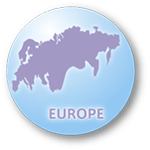 Peace Museums of EUROPE
Peace Museums of EUROPE
